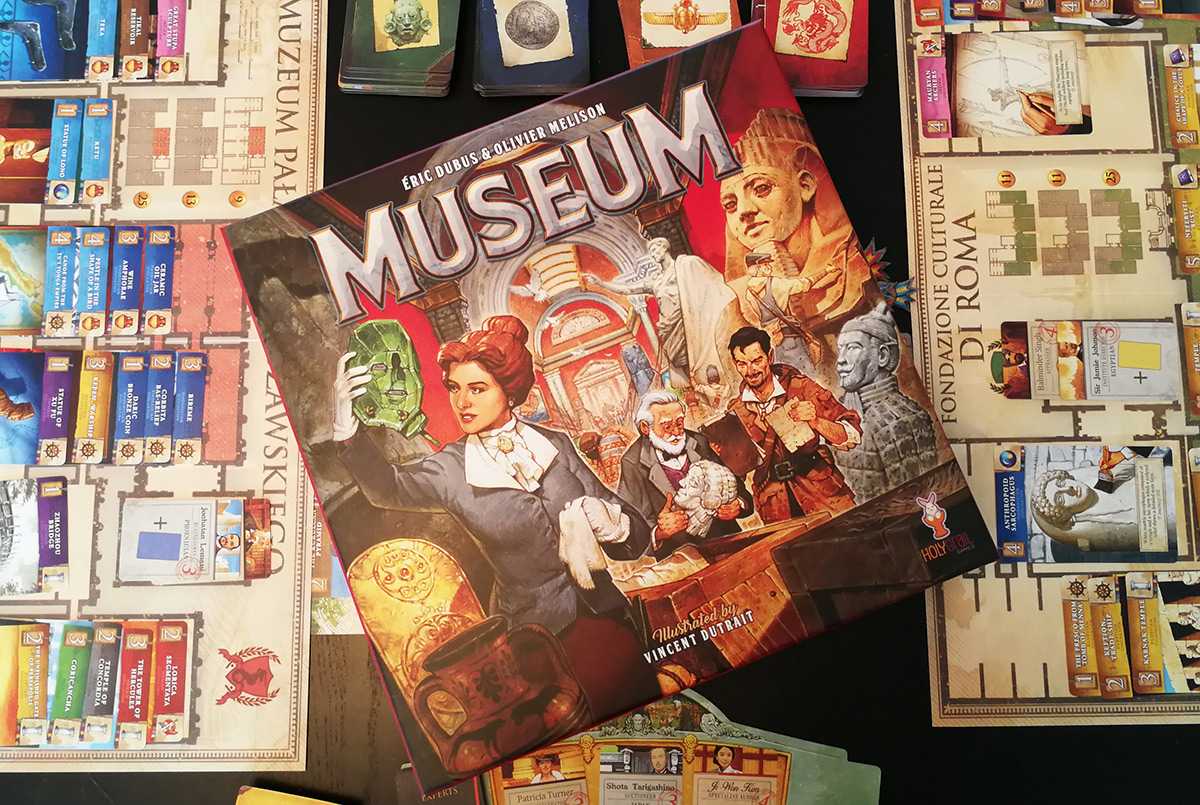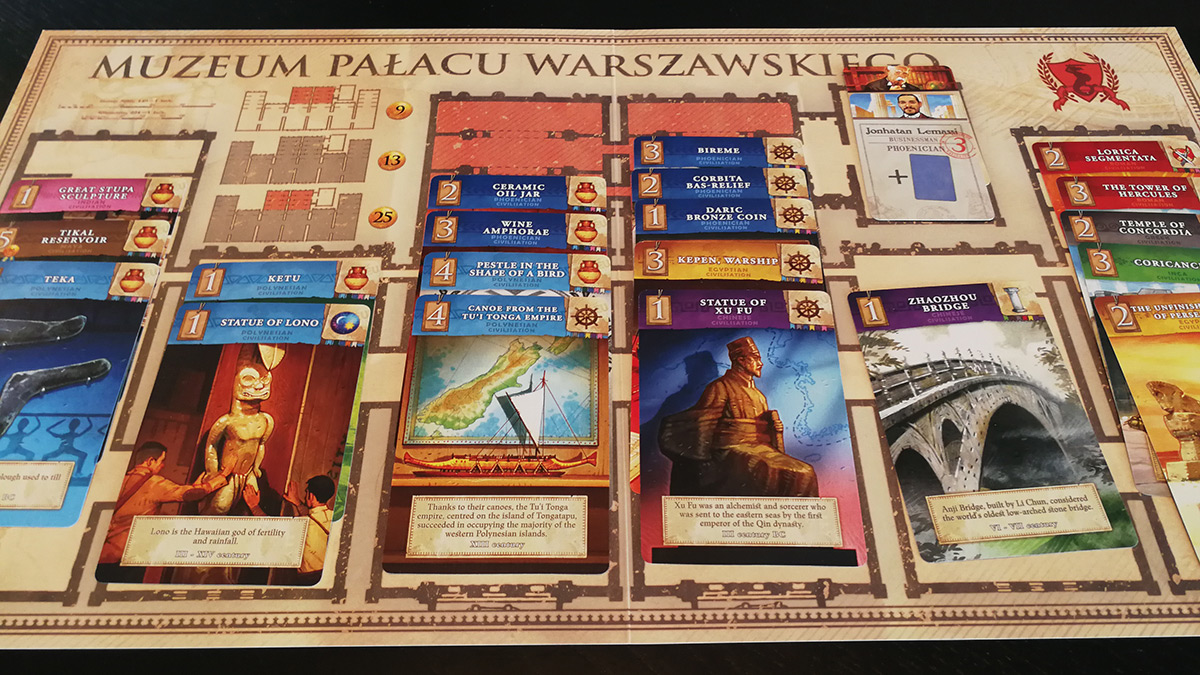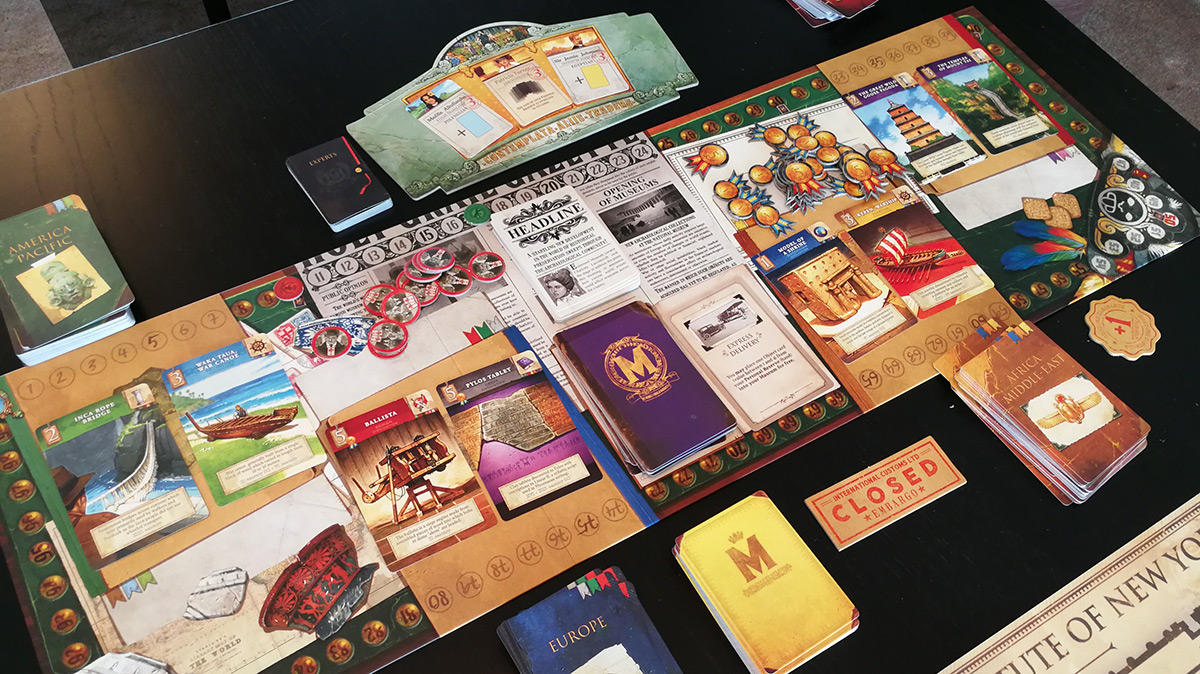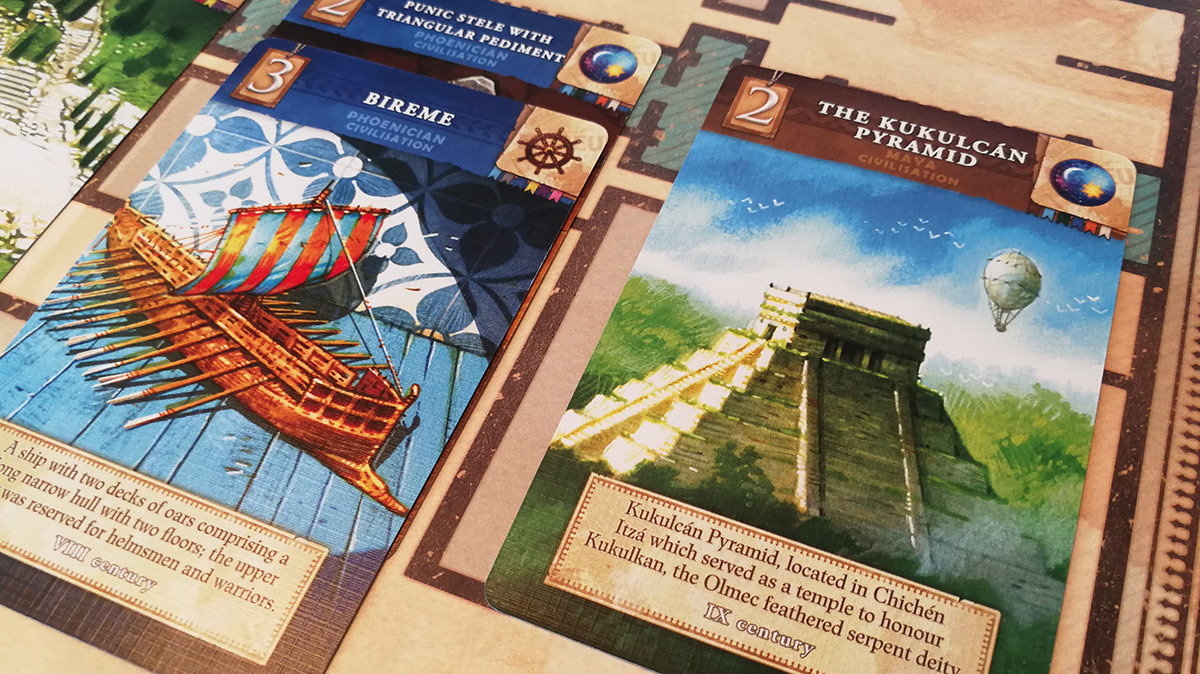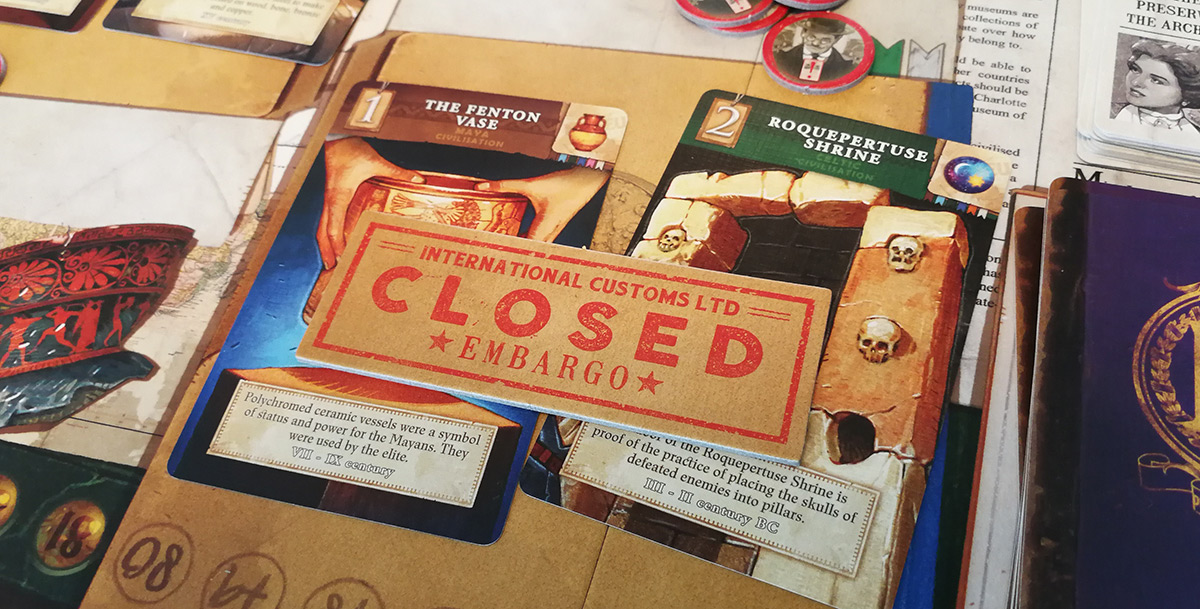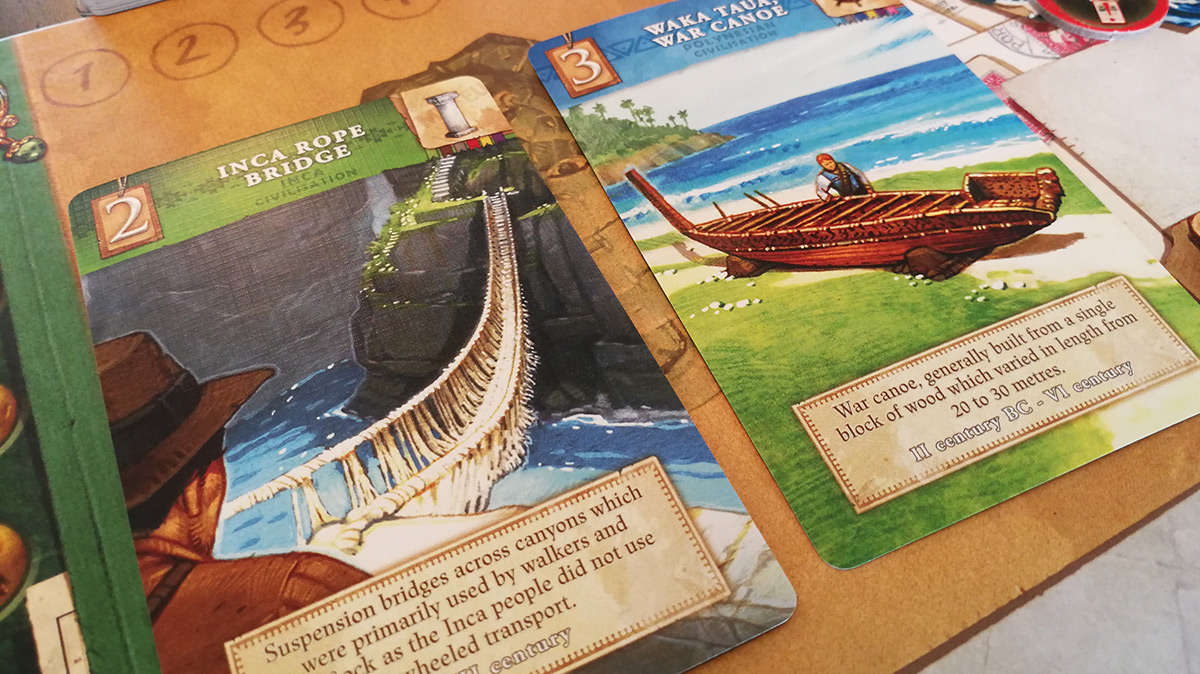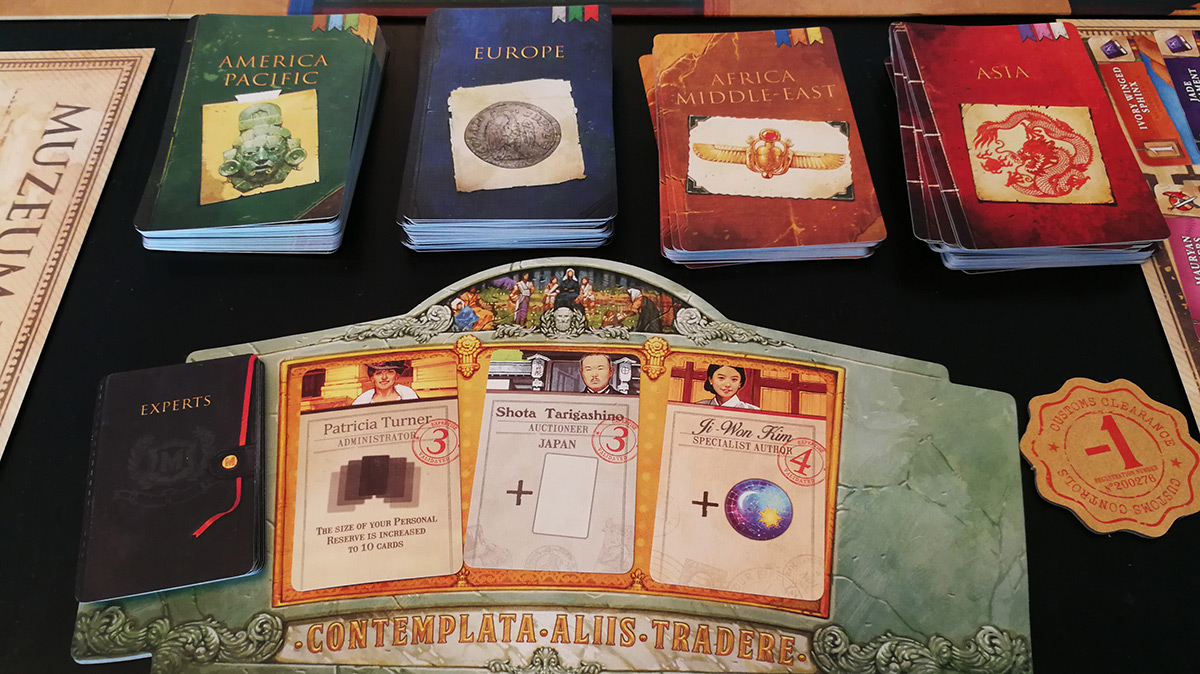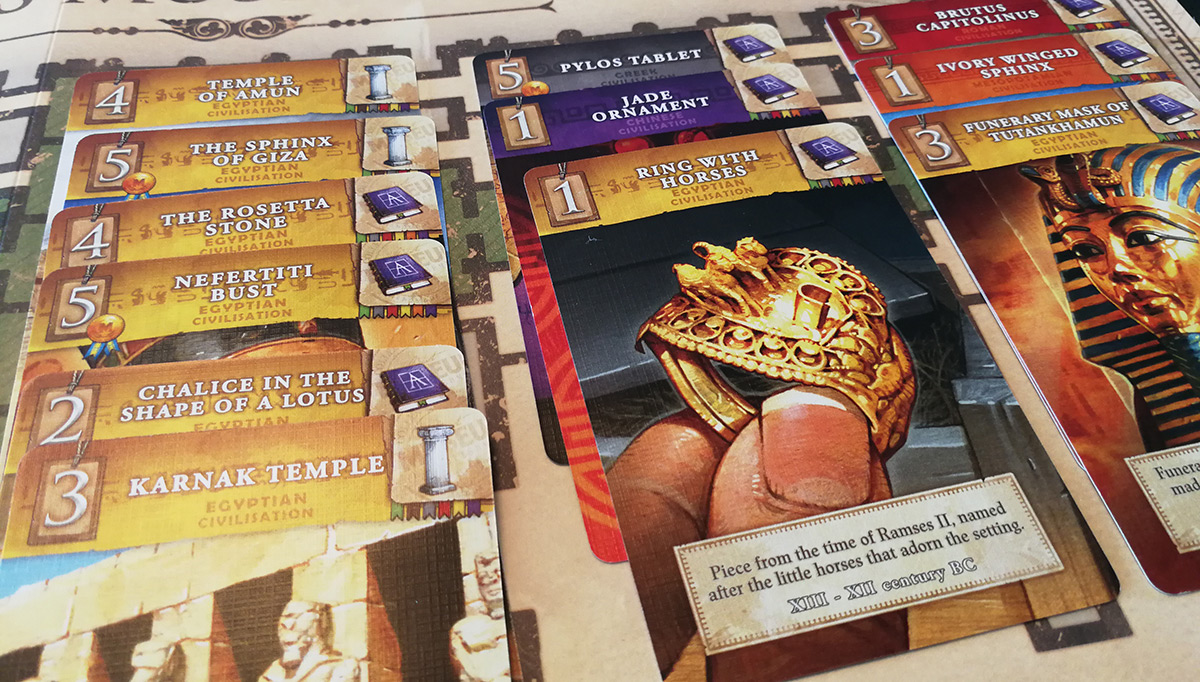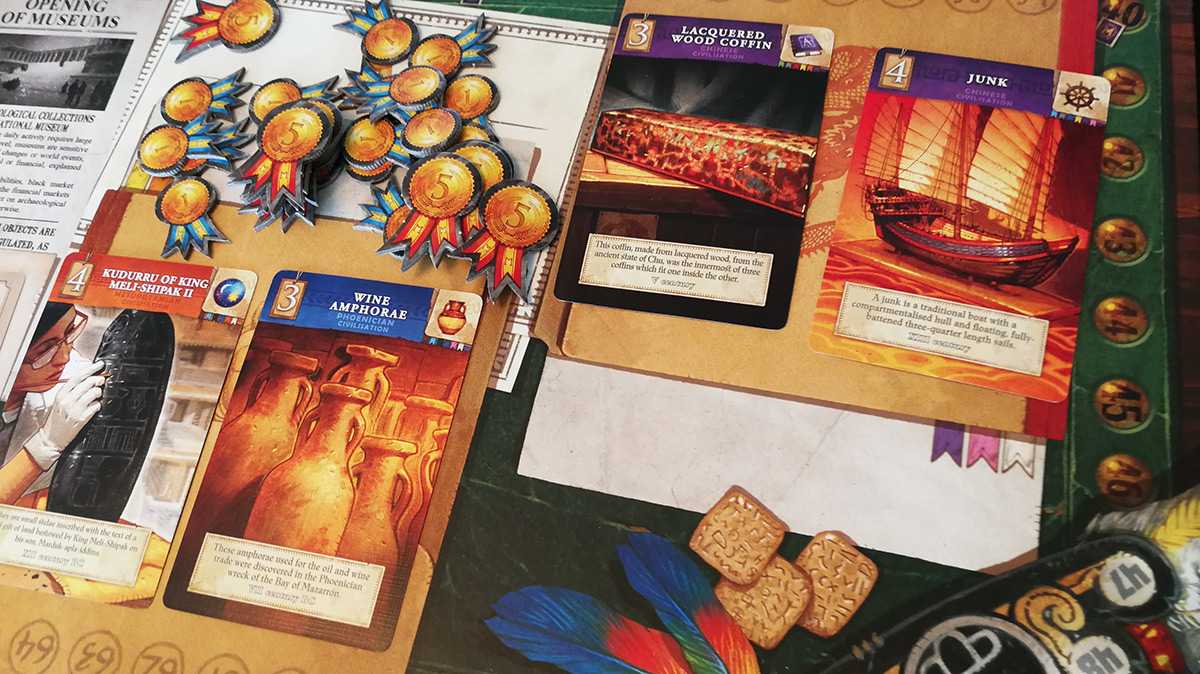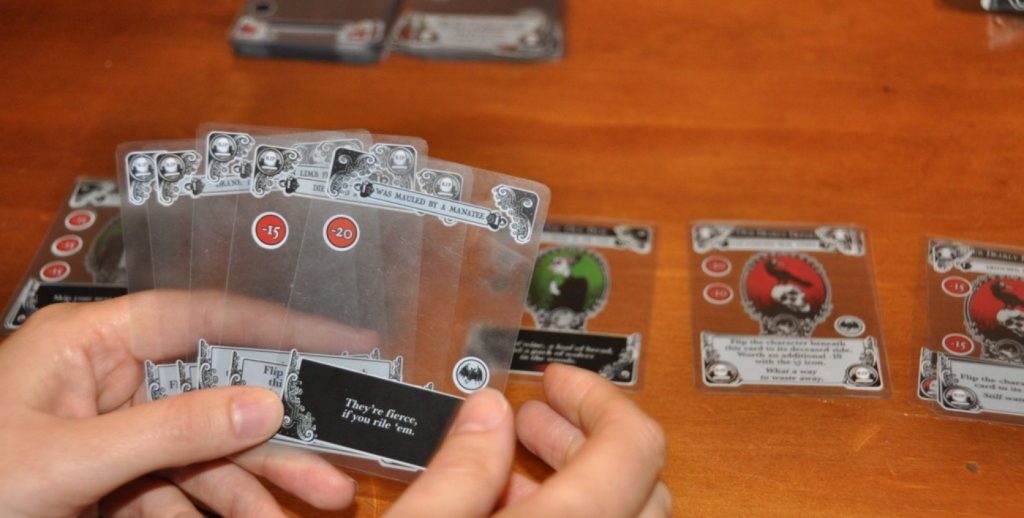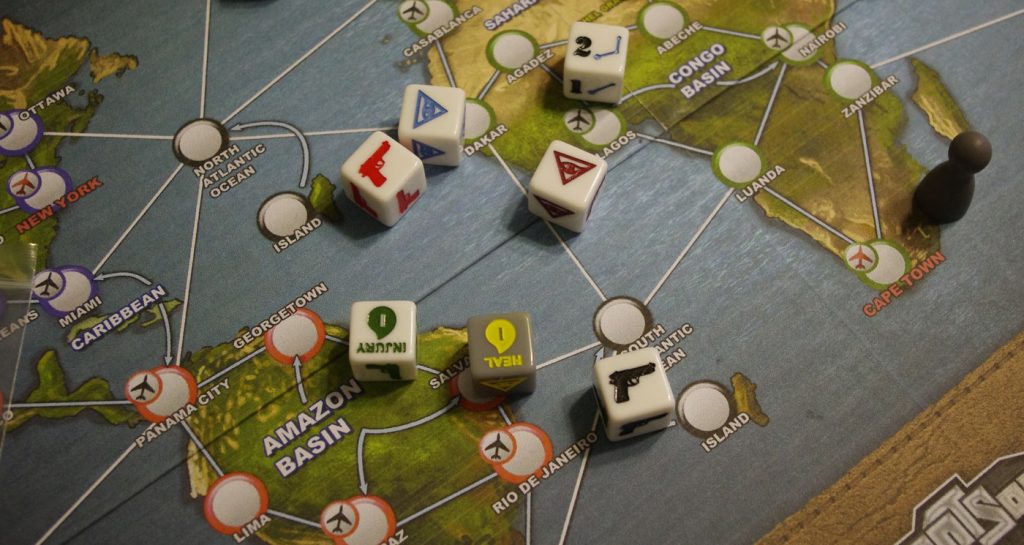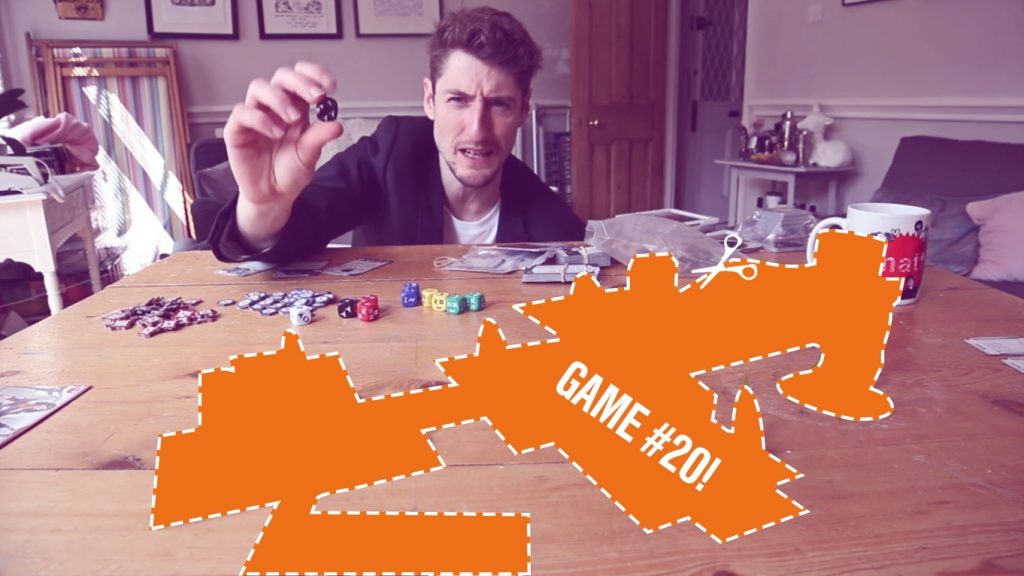Ava: Let us take you on a tour of the weirdest, most beautiful objects in the world. We can show you the largest palaces and the most specific digging implements, the canniest navigation tools and the shiniest hats you’ve ever seen.
Welcome to Museum, a game of archaeology (stealing), curation (re-arranging), and prestige (letter-writing).
Quinns: With over 300 gorgeous illustrations by Vincent Dutrait, Museum is the definition of a labour of love. In fact, Ava and I approached it like a real museum, taking a leisurely tour of its exhibits across two days.
Finally, we’re ready to write our review. Ava, do you want to explain the game?
Ava: Let me be your guide through the byzantine corridors…of board game.
Museum’s beating heart is your player board, laying out the galleries and corridors of one of the western world’s most famous museums. In the standard game, everyone’s playing to the same simple grid, but if you’re feeling fancy you can flip it over and explore a different layout.
To win Museum you need to earn the most prestige, and most of that comes from exhibiting cards representing a dazzling array of artefacts. You’re looking for sets of objects from a particular civilisation, or broadly themed items from a mix of civilisations. You might be collecting items related to warfare, culture or navigation from different parts of the world, making a museum dedicated to weapons, words and wetness.
But this ain’t Grandpappy Tut’s set collection. Your collections only score if they’re connected through the corridors and galleries of your actual museum. Either way, the shuffling of cards into stacks and chains, and the lovely crossovers between one collection and another – for example, a Greek boat sitting snugly between your collection of Greek things and naval things – is glorious fun to fiddle with.
Each turn an exploration phase lets everyone grab a card from the worldwide spread of archaeological digs. You might want a phoenican urn, a celtic spade or *ahem* the entire city of Tikal.
Curious leaps in scale aside, you get one artifact for free (colloquially known as ‘mugging’), and it becomes part of your hand of cards, just begging to be put in a glass cabinet for wandering visitors to gawk at. However, to get this card into your museum, you have to discard other items. If you want to display a 5 point monument, you might pay for it with a 3 point breastplate and a 2 point vase. Or maybe you’ll chuck away the monument to get a breastplate and vase combo that will really tie the room together.
Discarded cards gather dust in the back room of your museum. This is fine, as you can “inventory” your stock and place it back into your hand at the cost of one turn, but it’s not fine, because other museums might start poking around your cobwebbed shelves. Other players can give you cards from their hand (hoping you have no interest in them) in exchange for robbing your archives.
With a few exceptions, you’ll gain prestige from this, but if you were waiting to display that one beautiful bireme a little later? Well, you might be in trouble.
There’s an ebb and flow to Museum: spending cards, discarding them, grabbing them back and deciding once again exactly what to do with them. You could collect a few particularly fancy objects and use them over and over again to fuel your hunger for Celtic farm equipment. Or, you could go all out on the big and occasionally literal guns. Some of the nonsensically huge exhibits (say, Machu Picchu) get you bonus prestige, in the form of an extra currency that can be spent or saved at will. You slowly accrue this prestige when other people jump into your turn to take extra exploration actions, desperate to slake their thirst for pots.
And then. And then. And then… the bumf comes down.
Every ten points you earn? That gets you a favour card, labelled M for favour. These cards can be spent for some rule breaking power or another. Maybe you can exhibit for free. Sell something to a private buyer for bonus prestige. Hire an extra expert to bend yet another rule. Maybe you can choose to entirely ignore the public opinion mechanic. Or the headline mechanic.
Wait. Have I talked to you about those?
Sigh.
At the start of each round (except the first), a headline card is revealed to shuffle up the system. These are milder, generally giving a plus or minus to one tiny thing or another, occasionally closing the borders to a specific area, or making something cheaper or more expensive. If these come at the right or wrong time in your ebb and flow, that can be pretty frustrating, but none of it is game breaking. It’s just a little irritant, just a little bonus. It’s…fine.
Public opinion cards crop up in the decks you dig through to ‘borrow’ those precious exhibits. People will be grumpy if, at the end of the day, you’ve been hoarding stolen goods without dutifully showing them off. I was hoping this would provide some in-universe criticism of the colonialist side of a bunch of western museums grabbing as much as they can from other cultures, but the public is totally happy with you stealing the stuff, provided you have them in your front room instead of the back. Maybe that does represent a marginally fairer cultural exchange, but I’m not clear if this game is anything but a love letter to museums, unwilling to countenance post-colonial objections. Public opinion is mostly just a mild ticking off.
Quinns: Ha. Gosh, there’s a grim enjoyment in watching you slowly run out of steam as you explain Museum. I think it’s fair to say that this is a game that you and I both wanted to adore.
The multiple *enormous* decks of cards are full of more promise than a pile of birthday presents. Collecting your first few artifacts from one civilization and laying them out in your museum, while reading the cards to learn real-life history, is a wild ride. Especially because at the start of the game, you can really collect whatever you want. “That belongs in a Museum!” you cry, snatching up a Polynesian sea chart. “And that thing doesn’t,” you add, turning your back on the entire Phoenician civilisation.
Ava: Oh Quinns, you philistine, you really should visit Phoenis sometime.
Quinns: However, for a board game nerd like me… Museum simply wasn’t satisfying. The game as a whole reminds me of a pharoah’s sarcophagus- a breathtaking, gilded exterior, but what’s inside is a little dusty, and really quite lifeless.
Ava: It’s hard isn’t it. I could look at these cards for hours. Any excuse to get them out, shuffle them, and start poking through them should be worthwhile. Finding unusual objects with odd names and fascinating purposes? It’s like being in a museum, Quinns! With someone willing to really concisely explain one thing about every object, letting me be the touristy gadfly I always wanted to be.
Quinns: But it’s a good thing that Museum has all of this colour, because after our first two disappointing games of it, I grudgingly came to accept that it’s nowhere near as well-put-together as it appears. Ideally, games where you use cards to pay for other cards feel fascinating and taut as you have to decide which opportunities to pursue, and which to throw away. With Museum’s unevenly escalating scoring, you mostly know which cards are best for you, *and* you’re not truly throwing anything away, either. If you use an Incan item to pay for a Mayan item, you can still ultimately exhibit both. It’ll just take time. Tedious, tedious time.
And as much as we love those gargantuan decks of artifacts, they massively increase the variance in a set collection game like this. Ava, remember that one game where you absolutely crushed me because the Egyptian stuff you wanted came trundling out of the deck, while the cards that I needed were never even excavated?
Ava: None of the decks seem to do what you expect them to do. Everything here provides more clutter than treasure.
I can hire experts. All they do is give me a few extra points (apart from that one that makes everything cheaper). Public opinion might go against me. All it means is I have to watch my discard pile at the end, unless someone dumps a game-wrecking pile of trash in my back room on a whim. Most of the headline cards affect the choice of cards I can take from the artefact buffet in the middle of the table. All it means is I’ll get them a little later or little sooner.
But I don’t actually care about any of it.
I could spend hours re-arranging these cards in my museum, and the game constantly tries to pull me out of that pleasure. Lots of decisions don’t feed into that core at all. I’m shocked that Museum could work this hard to bore me about something I’m so up for being thrilled by.
Then there’s your museum layouts. You can’t clearly see the corridors under your cards, and have you piling up these beautiful cards under each other. You’re left with just a few symbols and some names, and oh my god I’ve buried the sphinx under a spade and it just needs to stay that way, and it’s heart-breaking to hide this stuff.
Quinns: Honestly? For me, if your personal Museum board shows anything off, it’s the whole box’s stumbling execution. There are two purposes of your board: limiting your space, and giving you a single grand gallery that you want to fill with one collection. But for the first 90% of the game space isn’t an issue, and depending on the luck of the draw, you may never have the option of filling your gallery. In a year when I’ve been playing a lot of roll’n’writes, a genre that thrills in letting players struggle to use the limited space given to them, Museum feels cavernously empty.
But do you know what?
Ava: Give it to me, Quintinkahmun.
Quinns: This box’s world-class presentation is almost enough to make me recommend it anyway.
…But then I remember you and me cross-referencing the manual, with cards, with Googling, trying to figure out the details of rules, like archaeologists piecing together pot fragments under a hot sun. It’s a simple game! Couldn’t they have at least delivered the rules cleanly?!
Ava: There are little irritations everywhere. The manual left me with really fundamental questions. Terminology is unnecessary muddling, even where obvious solutions are pointed to in the text. The game would be unplayably slow if people didn’t take the time to display their discard pile clearly to everybody, but nothing in the box actually says that.
Quinns: You and me were examining this game for multiple days, trying to figure out if we were missing something, playing something wrong, or just searching for the mysterious scroll that would tie this mess back together. At the end of the day, it shouldn’t take a pair of professional ludo-archaeologists this long to find a game’s flow.
Ava: There’s so many little pleasures here that I feel cruel putting so much weight on its fault lines. The cards are lovely. The structural set collection is chewy. There’s a wry smile in the grudging exchange of items and prestige throughout. There’s either a much simpler game struggling to get out, or a much tougher game tying knots around it. If I’m honest, I desperately want to pass these cards to someone else to make some magic with. Or just give designers Eric Dubus and Olivier Melison another year and a half with the rough block of stone they’ve given us and a tiny pickaxe. I’m sure they could find the diamond at Museum’s heart.

